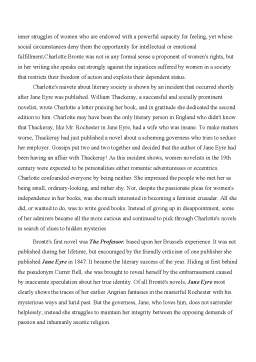Extras din referat
Charlotte Brontë was born on 21 April 1816 at Thornton in the west Riding of Yorkshire. Her father, Patrick Brontë (1777-1861), a native of County Down in Ireland, had risen above the poverty of his family to become an undergraduate at St. John's College, Cambridge, and in 1807 was ordained a priest in the Church of England. In 1812 he met, courted, and married Maria Branwell (1783-1821), a pious and educated young woman from Cornwall. Their life together was tragically brief; Maria bore six children in seven years ( Maria in 1813; Elizabeth, 1815; Charlotte 1816; Patrick Branwell 1817; Emily Jane, 1818; Anne 1820), then died of cancer in 1821 at the age of thirty-eight. Her death may have been hastened by the family's move in 1820 from Thornton to Haworth, where Mr. Brontë had been appointed perpetual curate.
In August 1824 Mr. Bronte send Charlotte to join Maria and Elizabeth at the recently opened Clergy Daughters' School at Cowan Bridge, near Tunstall in Lancashire. This was a charitable institution, where the daughters of poor clergymen might receive an education suited to their station and be prepared for future employment as governesses. Its founder was William Carus Wilson, a well-intentioned but overzealous clergyman who appears to have given little thought to the physical needs of the children in his charge; he imposed a stern regime of ascetic piety and self-denial which, in combination with inadequate attention to proper diet and the unhealthy situation of the school buildings, produced a succession of illnesses among the pupils and an outbreak of typhoid in April 1825. Both of Charlotte's older sisters, Maria and Elizabeth, came down with tuberculosis in 1825, and by the time the school notified Mr. Bronte, the girls were gravely ill. Maria died a few days after her return home, Elizabeth a few months later.
After this double tragedy, the surviving Bronte children were kept at home, where they were taught by their Aunt Branwell. In their free time, the three sisters and their brother, also called Branwell (it was his middle name) invented complicated fantasies and produced tiny, handwritten books. Many children still indulge in this form of make-believe, but writing down one's own fantasies was far more common in the days when children had fewer books and no television to entertain them.
What made the Brontes unusual was that for them the world of make-believe became more important than anything else. Emily and Anne were mainly involved in writing stories about an imaginary island in the Pacific, called Gondal. Charlotte and her brother concentrated on spinning tales about Angria, a fantasy kingdom in West Africa populated by immigrants from England and France, which was dominated by the Duke of Zamorna. Zamorna's lawless passions and amorous conquests make up the greater part of her contributions. Created in the image of Byronic satanism, he was proud, disillusioned, and masterful. He ruled by strength of will and feeling and easily conquered women , who recognized the evil in him but were drawn into helpless subjection by their own passion.
This dreamworld of unrestricted titanic emotions possessed Brontë with a terrible intensity, and the conflict between it and the realities of her life caused her great suffering. Thus, although her life was outwardly placid, she had inner experience of the struggles of will with circumstance and of desire with conscience that are the subject of her novels. Her conscience was an exceptionally powerful monitor.
In 1830, Mr. Bronte fell ill. Ironically, since he recovered to live to an advanced age, the lives of his three daughters were made miserable from that time on by the fear that their father would die and they would be left to support themselves. (Even more ironically, Mr. Bronte outlived all his children.) The next year, Charlotte was sent to school again. Roe Head, as the school was called, was a very pleasant place, not at all like Cowan Bridge. While Charlotte was an excellent student and made two lifelong friends during her two years at Roe Head, she was too shy to feel completely at ease in unfamiliar surroundings. After leaving school in 1832, at the age of sixteen, she spent most of the next ten years at home. The only exceptions were a two-and-a-half-year period when she went back to Roe Head as a teacher while first Emily and then Anne were pupils there, and two brief stints as a governess that lasted only about ten months altogether.
Preview document
Conținut arhivă zip
- About Charlote Bronte.doc












